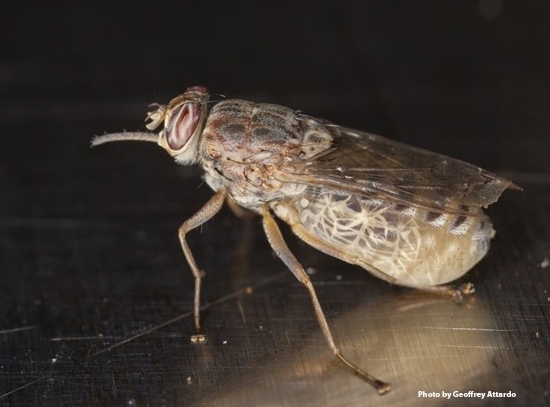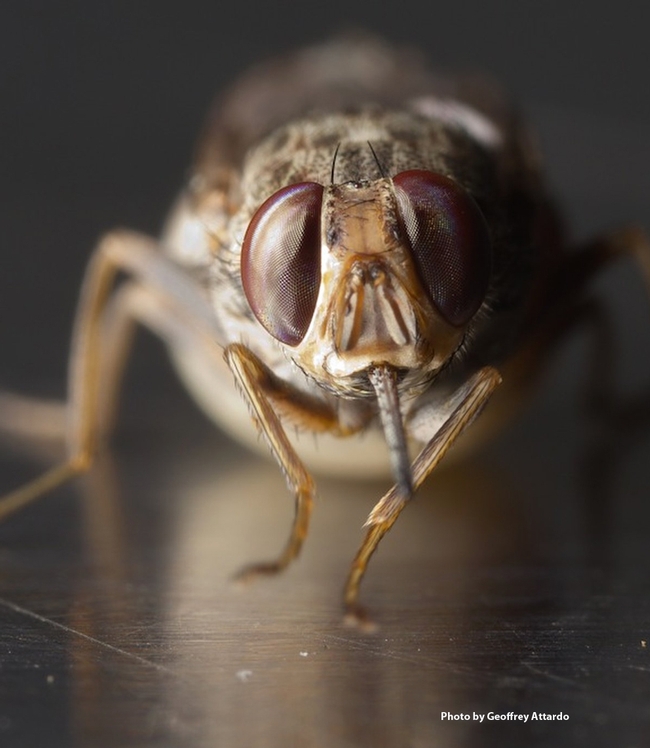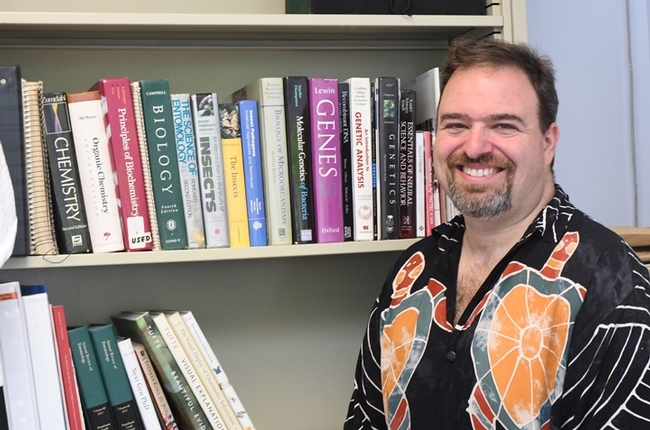Tsetse flies, large biting flies that inhabit much of Africa, feed on the blood of humans and other vertebrates and transmit such parasitic diseases as African trypanosomiasis. In humans, this disease is better known as sleeping sickness.
In 2009, after continued control efforts, the number of cases reported dropped below 10,000 (9878) for the first time in 50 years. This decline in number of cases has continued with 2804 new cases reported in 2015, the lowest level since the start of systematic global data-collection 76 years ago. The estimated number of actual cases is below 20 000 and the estimated population at risk is 65 million people.--World Health Organization
"Tsetse flies are the sole vectors of human and animal trypanosmiasis throughout sub-Saharan Africa," says Geoffrey Attardo, assistant professor, UC Davis Department of Entomology and Nematology.
He'll present a seminar on "Comparative Genomic Anaylsis of the Tsetse Fly: The Genetics of Lactation, Seminal Proteins and Other Unique Adaptations" at 4:10 p.m., Wednesday, Oct. 10 in 122 Briggs Hall. (He is also chairing the department's seminars for the 2018-2019 academic year.)
Attardo says that these "flies are distinguished from other Diptera by unique adaptations including male specific reproductive adaptations, lactation and the birthing of live young (obligate viviparity), exclusive blood feeding by to the sexes and visually based host seeking. To understand the genetic changes underlying these adaptations, we sequence the genomes of six species of tsetse flies representing three sub-genera. These sub-genera represent different habitats, host preferences and vectorial capacity."
In his talk, he will "describe some of our findings from these analyses and how the genetics of these flies compare with relatives such as Drosophila, with an emphasis on the genetic changes underlying tsetse's dramatic reproductive adaptations. In addition, we will discuss observations associated with visual, olfactory, and salivary biology, as well as the identification of features novel to Glossina and their respective sub-genera."
Attardo joined the department July 1, 2017 as an assistant professor after 13 years at the Yale University School of Public Health, New Haven, Conn., first as a postdoctoral fellow from 2004 to 2008, and then as associate research scientist and research scientist

“I got my start in science working as an undergraduate researcher” at the University of Massachusetts in the lab of John Edman, who moved to UC Davis in 1999. There Geoffrey reared and worked with various mosquito species and kissing bugs for four to five years. He also worked on aspects of mosquito ecology, reproduction and nutrition with Edman and Thomas Scott, now both UC Davis emeriti professors of entomology.
“I decided to develop my career in science and went to work in Dr. Alexander Raikhel's lab at Michigan State University as a graduate student. I was always drawn to understanding the molecular mechanisms underlying the extreme biology of insects and Dr. Raikhel's lab provided that opportunity. There I focused on the molecular biology of egg development in mosquitoes.”
After receiving his doctorate, Attardo joined the Yale lab of Serap Aksoy to work on tsetse flies. “In terms of fascinating physiological adaptations, the tsetse fly is one of the champions of the insect world!” Attardo says. “In addition to being vectors of a deadly disease, Trypanosomiasis, these flies have undergone amazing alterations to their physiology relative to other insects. Some examples of this are their ability feed exclusively on blood, their obligate relationship with a bacterial symbiont, the fact that they lactate and that they give birth to fully developed larval offspring. The opportunity to study the adaptations these flies have made is like opening a toy chest for an insect physiologist. My work in tsetse has focused on the molecular biology underlying the adaptations associated with the development of lactation, symbiosis, male and female mating interactions/physiology and nutrient metabolism and mobilization.”
In research on mosquitoes, Attardo demonstrated that mosquitoes require nutritional cues to begin egg development. “Egg development had been known to be regulated by a steroid hormone called 20-hydroxyecdysone,” Attardo explained. “However, treatment of mosquitoes with this hormone along did not activate egg development. My research showed that when female mosquitoes take blood, the protein in the blood is broken down into amino acids which in combination with the hormone activate egg development. Either amino acids or the hormone along were not capable of activating this process, but when they are combined it unlocks a massive physiological change which causes the production of yolk proteins and activation of egg development.”
One of the highlights of his career: the publication of the tsetse fly genome in the journal Science. He served as the annotation coordinator, editor and illustrator for the publication. One of his tsetse fly images graced the cover. “The publication of the genome opened up new avenues of research in tsetse that were previously unavailable and facilitates more work to be done on this important disease vector by making all this data available to the community,” Attardo related. “I am working on following up this work with a paper comparing the genome sequences of six different species of tsetse flies that differ in their geographic, ecological, host preference and vectorial capacity characteristics. We hope to connect the underlying genetics of these flies with with these differing life traits to understand their biology, evolution and identify potential targets with which to control this vector.”
A native of Poughkeepsie, N.Y., Geoffrey received his bachelor's degree in entomology from the University of Massachusetts, Amherst, in 1994 and his doctorate in genetics from Michigan State University, East Lansing, in 2004.
A career in science came naturally. “My parents are both somewhat scientifically inclined, so I may have taken after them,” he says. “My father has a doctorate in metallurgy from Columbia University and led a long successful career at IBM. My mom was a full-time mom, but has a background in microbiology with a master's degree from Yale.”
(Editor's note: See list of seminars for the fall quarter.)
Attached Images:

